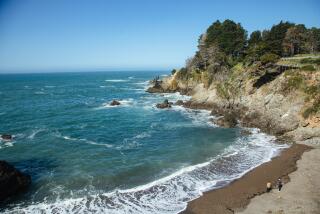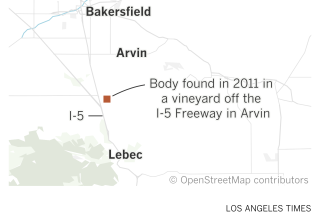20 years later, San Diego police identify woman’s body found burning behind church
- Share via
SAN DIEGO — For 20 years, the young woman whose hands were chopped off and whose body was found burning behind a San Diego church was identified only as Jane Doe.
But last year, as cold-case investigators scoured ancestral DNA databases looking for potential relatives of the victim, they caught a break. A man in Michigan who was adopted as a child had just uploaded his genetic information into one of those databases in search of his biological family — and investigators determined he was Jane Doe’s half-brother.
Now, San Diego police cold-case homicide investigators know the victim found Jan. 24, 2000, was 20-year-old Nicole Weis. According to police, she grew up in Michigan but lost touch with her family in the late 1990s when she moved to Los Angeles, where it’s believed she probably lived at the time of her death.
What detectives don’t yet know is who killed Weis and set fire to her body, which had been wrapped in cardboard and secured with a rope, in the parking lot of College Avenue Baptist Church, off College Avenue and El Cajon Boulevard.
In a video about the case, produced by the San Diego Police Department, Sgt. Ronnie Philhower described being a patrol officer in January 2000 and showing up first at the scene about 12:15 a.m. to find the body engulfed in flames.
A news story from the time described the body as “burned beyond recognition.” A homicide lieutenant said that the victim was dead by the time officers arrived and that she may have been killed elsewhere before being dumped behind the church.
Police later commissioned an artist’s rendering of the victim, but for nearly two decades, no leads emerged based on the sketch and her identity remained a mystery, according to cold-case investigator Det. Lori Adams. So in 2019, detectives enlisted the help of Barbara Rae-Venter, the genealogist who helped crack the case of Joseph James DeAngelo Jr., known as the Golden State Killer.
The way investigative genetic genealogy works is that police upload DNA from a crime scene into a public repository of DNA profiles, in hopes that the evidence shares markers with what’s already in the database. The more markers shared, the closer the relationship and the smaller the family tree.
But if the familial connections are too distant, the family tree is large, with many potential branches to follow. That was the case when San Diego homicide detectives first uploaded Jane Doe’s DNA — they found only distant relatives.
As investigators were doing the methodical process-of-elimination work needed to identify the victim, adoptee Glen Stevenson uploaded his DNA information. It was a close match to Jane Doe, who detectives determined was his half-sister.
From there, detectives tracked down another daughter of Stevenson’s biological father, a Michigan woman named Kimberly Beach. She told police she had a sister who lost contact with the family in the late 1990s.
“We obtained Kimberly Beach’s DNA, and compared it to Jane Doe,” Adams, the cold-case detective, said in the police video. “It verified they are biological siblings. We now had Jane Doe’s real name: Nicole Weis.”
With the victim’s identity confirmed, cold-case detectives are now seeking to speak with anyone who knew Weis or anyone with information about the killing. Those people can call the San Diego Police Department’s homicide unit at (619) 531-2293, or the San Diego County Crime Stoppers anonymous tip line at (888) 580-8477.
More to Read
Sign up for Essential California
The most important California stories and recommendations in your inbox every morning.
You may occasionally receive promotional content from the Los Angeles Times.














